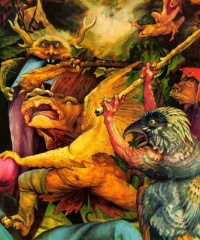Temptation of Saint Anthony in visual arts
From The Art and Popular Culture Encyclopedia
|
"[Demons] taking the forms of women, wild beasts, creeping things."--Life of Antony "Several painters have handled a subject of this kind, with a view of assembling as many horrid phantoms as their imagination could suggest; but all the designs I have chanced to meet of the temptation of St. Anthony were rather a sort of odd, wild grotesques, than anything capable of producing a serious passion. In all these subjects poetry is very happy. Its apparitions, its chimeras, its harpies, its allegorical figures, are grand and affecting; and though Virgil’s Fame and Homer’s Discord are obscure, they are magnificent figures. These figures in painting would be clear enough, but I fear they might become ridiculous." --A Philosophical Enquiry into the Origin of Our Ideas of the Sublime and Beautiful (1757) by Edmund Burke "A unique painter in the Flemish tradition was Hieronymus Bosch (about 1450-1516). In his ideology medieval fantasy and grotesquerie reached a zenith. But his inexhaustible, audacious fantasy, which invented all kinds of diabolical creatures, found expression in clear, skillfully organized pictorial forms. Usually a landscape or an architectural framework, receding into space, provided the setting for figures that show Northern realism in detail and Gothic linealism in the crisp edges of the color areas, strongly opposed in value. All this is evident in any of his versions of The Temptation of Saint Anthony, a subject he painted frequently." --Gardner's Art Through the Ages (1926) by Helen Gardner |
|
Related e |
|
Featured: |
The Temptation (or Temptations) of St. Anthony is a popular theme in the history of Western art. Many visual artists have depicted these incidents from the life of Saint Anthony as told in Life of Antony.
Some of the stories of the demons and temptations that Saint Anthony is reported to have faced are perpetuated now mostly in paintings, where they give an opportunity and pretext for artists to depict their more lurid or bizarre fantasies. Emphasis on these stories, however, did not really begin until the Middle Ages, when the psychology of the individual became a greater interest.
Contents |
History
10th century
The subject of Saint Anthony was first presented in the 10th century at Italian fresco paintings. In the European Middle Ages one can watch an accumulation of the theme in book illumination and later in German woodcuts.
Middle Ages
About 1500 originated the famous prints and paintings of Martin Schöngauer (ca. 1490), Hieronymus Bosch (ca. 1505) and Matthias Grünewald (ca. 1510).
- Isenheim Altarpiece
- The Temptation of St Anthony (Bosch painting)
- The Temptation of St. Anthony (Bosch triptych)
- The temptation of St. Anthony (Breughel drawing)
17th century
- The Temptation of St. Anthony (Callot)
- Temptation of Saint Anthony, 1640s, Salvator Rosa, oil on canvas, 125 x 93 cm. Galleria Pitti, Florence
19th century
- The temptation of St. Anthony (John Charles Dollman)
- The Temptation of Saint Anthony (1878) Félicien Rops
20th century and contemporary art
Dalí
Modern Spanish painter Salvador Dalí drew a great deal of inspiration from Bosch's work, which had many of the features that acted as precursors to Dalí's own surrealism. Dalí's version depicts St. Anthony resisting temptations associated with a spider-legged horse and elephants. The "space elephants," distorted offspring of Gian Lorenzo Bernini's elephant and obelisk, are a motif in Dalí's work.
Notable versions of the subject
- Saint Anthony Abbot Tempted by a Heap of Gold, Sienese, 15th-century
- The Temptation of St Anthony, a widely-circulated engraving by Martin Schongauer
- The Temptation of Saint Anthony (Michelangelo), a 15th-century painting by Michelangelo (his first), which was painted after the Schongauer engraving, in the Kimbell Museum in Ft. Worth.
- Triptych of the Temptation of St. Anthony, Hieronymus Bosch, c. 1501.
- The Temptation of St Anthony (Bosch painting), a 16th-century painting by Hieronymus Bosch or a follower, in the Prado Museum in Madrid.
- The Temptation of St Anthony, another Bosch version, in Kansas City
- Isenheim Altarpiece by Matthias Grünewald (1512-1516)
- The Temptation of St. Anthony, a 1547 painting by Pieter Huys
- The Temptation of Saint Anthony (Carracci), a 1598-1600 painting by Annibale Carracci
- The Temptation of St. Anthony, a c. 1650 work by David Teniers the Younger
- The Temptation of St. Anthony, a 1650 painting by Joos van Craesbeeck
- The Temptation of Saint Anthony, several 17th-century paintings by Mattheus van Helmont
- The Temptation of St. Antonius, an 1887 painting by Paul Cézanne
- The Temptation of St. Anthony, an 1897 painting by Lovis Corinth
- The Temptation of Saint Anthony (Ernst painting), a 1945 painting by Max Ernst
- The Temptation of St. Anthony (Dalí), a 1946 painting by Salvador Dalí
- The Temptation of St. Anthony, 1942-5, a series of paintings by Michael Ayrton
- The Temptation of St. Anthony, a 1947 painting by Leonora Carrington
- The Temptation of Saint Anthony, a fictional modern painting featured in Kurt Vonnegut's 1973 novel Breakfast of Champions.
- The Temptation of St. Anthony, a 1645 print by Jacques Callot
See also
- Pretexts for prurience in art
- The Temptation of St Anthony (Bosch painting)
- Triptych of the Temptation of St. Anthony
- Isenheim Altarpiece — Paul Hindemith composed his work Mathis der Maler based on this triptych, of which the movement die Versuchung der Heiligen Antonius (“The Temptation of St. Anthony”) starkly depicts this using very modern musical gestures.
- The Torment of Saint Anthony (Michelangelo)
- Anthony the Great
- Fantastic art
- Temptation


